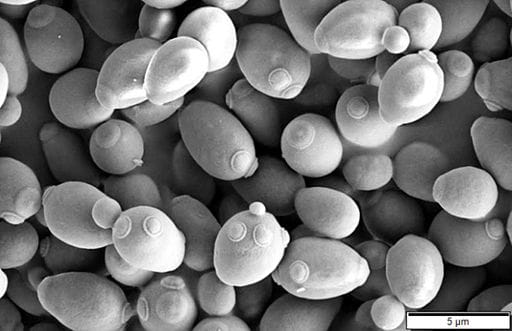The S. cerevisiae 2.0 project is aimed at producing a living yeast with a fully synthetic genome. After a first synthetic chromosome was created in 2014, five more were added this year. Notably, trans-omic analysis has found no significant differences between synthetic and natural yeast. This ambitious project has made a range of contributions to the life sciences, including the discovery of disease mechanisms and new cellular processes.
Thanks to advances in DNA synthesis technology, the genetic material of any organism can now be recreated chemically. An international scientific team was formed to reconstruct the genome of one of the most intensively studied eukaryotic model organisms, the yeast Saccharomyces cerevisiae. The S. cerevisiae 2.0 (Sc2.0) project is aimed at building a designer yeast genome from scratch. Synthesizing designer chromosomes and genomes in their entirety is considered a new direction regarding the study of genes and biological systems.
This year, five yeast chromosomes (SynV, SynII, Syn VI, SynX, and SynXII) were successfully synthesized chemically. The first synthetic yeast chromosome (SynIII) was constructed in 2014. The goal is for all 16 chromosomes to have a synthetic counterpart by 2018.
Building a chromosome from scratch
The goals of the Sc2.0 project are to design and create a synthetic S. cerevisiae genome in which the “wild type” phenotype is maintained, and the final assembled synthetic genome perfectly matches the designed sequence. The genome’s synthetic equivalent is also designed to increase genetic stability and flexibility.
-
The Sc2.0 aims to design and create an entirely synthetic yeast genome
-
Five new synthetic yeast chromosomes have been ceated this year
-
Despite drastic sequence alterations, the wild type and synthetic yeast strains are phenotypically indistinguishable
The starting point of the project is the wild type S. cerevisiae DNA sequence. In silico, the chromosome is divided into mega chunks, and each mega chunk is in turn separated into a set of smaller pieces. Once the in silico chromosome design is complete, the in vitro process begins. The smaller pieces are chemically synthesized and fused through restriction enzyme cutting and ligation to form mega chunks. The mega chunks, which replace the corresponding wild type segment, are then integrated into the host genome. Finally, all synthetic chromosomes are validated through whole genome sequencing. The fitness levels of the semisynthetic yeast strains are tested to detect potential defects. Any defects must be corrected through transformation of the defective synthetic sequence into the wild type sequence. Once an entire synthetic chromosome is functional within a yeast strain, different synthetic chromosomes can be brought together into a single strain via mating and sporulation.
You can’t notice the difference
Despite significant sequence alterations, wild type yeast and yeast with synthetic chromosomes are almost indistinguishable. Growth curves and phenotype and morphology tests were used to compare the fitness levels of both synthetic and wild type yeasts. The results found their fitness levels to be nearly identical. Trans-omic analysis revealed that the biological processes of synthetic S. cerevisiae are similar to the wild type strain, which proves that the yeast genome has a great degree of plasticity, and it can tolerate significant editing. The synthetic genome is perfectly capable of directing all normal biological functions. In addition, it can self-replicate and produce daughter cells.
Bringing synthetic chromosomes together into a single strain seems to be well tolerated by the yeast. Based on transcriptome and proteome analysis, cellular networks are unperturbed in yeast cells with multiple synthetic chromosomes. Additionally, due to the removal of repeats, synthetic chromosomes are shorter than their wild type counterparts.
The future of synthetics
Yeast models from Sc2.0 could prove to be valuable for studying ring chromosomes, which have been linked to human genetic disorders, such as epilepsy and leukemia. Through modeling, new methods can also be proposed to reverse growth defects.
The identification of defects in synthetic chromosomes elicits a better understanding of genome biology. Through analysis of these defects, new details of yeast biology have been discovered, such as novel binding sites for known transcription factors.
Synthetic chromosomes significantly change genomes, mainly through the removal of tRNA genes and repeated sequences, which are notoriously unstable. Investigating the impact of these deletions might offer valuable insights into the regulatory influences of repeated sequences.
Designing living organisms with genomes that not only differ from native genomes but perhaps even have new functions is the next big step. Although this sounds like science fiction today, it could be a reality in the not-too-distant future.
Article by guest contributor Elka Van Oosterhout.
References
Richardson, S. et al. Design of a synthetic yeast genome. Science, 2017, Volume 355, 1040 – 1044
Zhang, W. et al. Engineering the ribosomal DNA in a megabase synthetic chromosome. Science, 2017, Volume 355, 1049
Mercy, G. et al. 3D organization of synthetic and scrambled chromosomes. Science, 2017 Volume 355, 1050
Xie, Ze-Xiong et al. “Perfect” designer chromosome V and behavior of a ring derivative. Science, 2017, Volume 355, 1046
Wu, Yi et al. Bug mapping and fitness testing of chemically synthesized chromosome X. Science, 2017, Volume 355, 1048
Shen, Yue et al. Deep functional analysis of synII, a 770-kilobase synthetic yeast chromosome. Science, 2017, Volume 355, 1047
Mitchell, Leslie et al. Synthesis, debugging and effects of synthetic chromosome consolidation: synVI and beyond. Science, 2017, Volume 355, 1045


